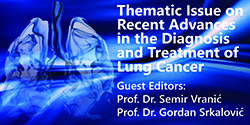Characteristics of Patients with Nonvariceal Upper Gastrointestinal Bleeding - Are We Underestimating Gastroprotection during NSAIDs Therapy?
DOI:
https://doi.org/10.5644/ama2006-124.340Keywords:
Mortality, Transfusion, Forrest ClassificationAbstract
Objective. The aim of our study was to determine the etiological factors, treatment and outcome of patients with non-variceal bleeding from upper gastrointestinal tract.
Materials and Methods. This study enrolled 200 patients admitted to Sarajevo University Clinical Center with signs and symptoms of upper gastrointestinal bleeding, from January 2019 to July 2020. All patients had undergone gastroscopy, confirming the cause of gastrointestinal bleeding. Clinical and laboratory data were collected retrospectively, including previous non-steroid antiinflammatory drugs (NSAIDs) and anticoagulant therapy, comorbidities, risk factors, as well as endoscopic findings, laboratory findings, treatment and clinical follow-up.
Results. The majority of patients were men (59%) with an average age of 53±6 years. Duodenal and gastric ulcers were the most common cause, followed by other etiologies. In our study, previous NSAIDs therapy had been registered in 29.5% of patients, anticoagulants in 8%, and proton pump inhibitors (PPI) in 2.9% of patients. Endoscopic intervention was required in 34% of patients. The need for transfusion occurred in 44.5% of cases. Rebleeding during hospitalization was observed in 7.5% of patients, mortality in 1.5% and surgery in 3% of patients.
Conclusion. The patients admitted to our hospital with symptoms of acute nonvariceal upper gastrointestinal bleeding were elderly, predominantly males, with significant comorbidities and a higher incidence of NSAID use. Gastroprotection is underutilized during NSAID treatment in patients with other coexisting risk factors,with a low rate of concomitant use of PPI during NSAIDs therapy. Endoscopic therapy, together with PPI, significantly reduces rebleeding rates, mortality and the number of emergency surgical interventions.
Downloads
Published
Issue
Section
License
Copyright (c) 2021 Nerma Čustović, Aida Saray, Samra Ćato-Mehmedbašić, Ira Tančica, Sanjin Sprečkić, Nedim Tokić, Naida Herenda

This work is licensed under a Creative Commons Attribution-NonCommercial 4.0 International License.






